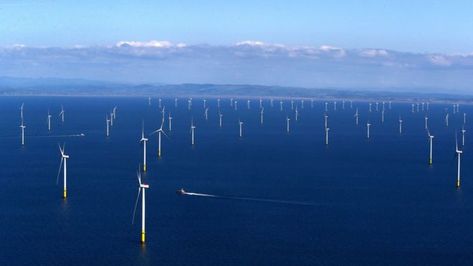by Samuel Allen
A collaboration between chemists and physicists at Hebei University and the Chinese Academy of Sciences has produced a new method to generate electricity from low-speed wind by exploiting the internal rotation of ionic liquid droplets – a technological breakthrough with the potential to drastically improve the versatility of wind power technologies and bring clean energy generation to more places than ever before.[1]
What’s wrong with current wind power technologies?
Wind power has grown in popularity enormously in the last twenty years, and now generates around 27% of the UK’s electricity[2] and accounts for over 6% of the world’s supply.[1] Wind power is favoured as it is low-maintenance, completely carbon neutral to operate, comparatively cheap, and scalable. Also, contrary to popular belief, it doesn’t kill masses of birds,[3] give you ADHD, or cause tinnitus.[4] Furthermore, it isn’t considered a serious eyesore like large-scale solar farms or hydroelectric dams, which tends to keep nimbyists1 a little happier than they are with other green alternatives.

Figure 1: The Walney wind farm in the Irish sea – one of the largest in the world. Photo: PA images
However, wind power suffers from one catastrophic (and thus far unavoidable) Achilles’ heel: what do you do if it’s not windy? The answer, until now, was nothing. The reliance of wind power on wind speed is hardly shocking, but you may be surprised to learn that the power generated by a wind turbine varies with the cube of the wind speed. This means that below wind speeds of around 5 ms−1 traditional wind turbines are effectively useless. Areas with average windspeed below this level cover well over 75 % of earth’s land surface,[5] including almost all forested and urban areas. Of course, this wind speed required is the average wind speed perpendicular to the plane of the turbine blades, so in reality this dependence necessitates a consistent wind direction too. In cases where the wind speed is too low, or the wind direction is highly changeable, the economic and environmental costs of the construction and maintenance of the turbines outweighs any power they might generate. This seriously limits the sites at which it is viable to install them to mostly flat plains, offshore sites, and coastal areas – the consensus in the literature and industry is that terrain and wind current distribution favours Europe and North America when it comes to suitable wind farm sites.[5]
The weaknesses of current wind power technologies don’t end with their need for fast and consistent wind. They are also reliant on the area swept out by the turbine blades and the air density – no use if you need energy in a confined space or at high altitude. The wind also can’t be too fast – the keen observer will note that in high winds turbines are often stationary – when they are shut down to avoid damage to their internal mechanisms. These same internal mechanisms that break in high winds also require frequent maintenance due to their moving parts. All in all, then, wind power is a fantastic renewable energy source which is tragically restrained by its requirement for very specific and often unrealistic conditions.
The new approach: ionic liquid arrays for Drop Wind Generators (DWGs)
The approach developed by the teams at Hebei University and the Chinese Academy of Sciences has the potential to solve all the highlighted problems of conventional wind power by simply throwing away the turbine blades. Instead, their approach uses the internal rotation of ionic liquids to harvest the wind’s power in a “drop wind generator” (DWG). DWGs use suspended droplets of an ionic liquid (in this case, 3-methyl-1-octylimidazolium chloride) on a nanowire array which is exposed to the wind. The properties of the liquid droplets mean that the friction at the liquid/air surface as the wind passes over them causes rotation within the liquid, which is usually dissipated as heat due to internal friction. By restricting the liquid’s movement on its nanowire array by “pinning” it in place, the internal motion causes separation of the positive and negative ions within the liquid, instead of heating. This leads to a surface charge redistribution, creating a potential difference which can then be used to “persistently generate electricity.”[1] The properties of the liquid also help to stabilise a bulbous droplet shape, which can generate even more friction at the liquid-air boundary than alternative liquids.

Figure 2: The ionic liquid droplet, showing the region the potential difference is generated between. The diagram includes the schematic structure of the ions in the ionic liquid 3-methyl-1-octylimidazolium chloride. Reproduced from [1].
The recent study demonstrated the feasibility of this basic mechanism for generating usable currents from winds as low as 0.2 ms−1, with individual cells generating potential differences around 0.84 V.[1] By combining these cells into ionic drop “wind farms,” the team has managed to scale up the process to generate around 60 V. The hope is that by expanding these “farms” of ionic liquid droplets and nanowire arrays, the potential difference can be increased even further. Even in its current state, the voltages generated are sufficient to have practical applications in powering small-scale electronics.
Implications of the new technology
How does this new approach resolve wind power’s fatal flaw? It is quite simple. By eliminating the turbine mechanism this new technology has eliminated in one stroke the need for high and consistent wind speeds. In doing so, it has also reduced the need for large spaces, frequent maintenance, and high air density. Development of this approach further will make wind power undoubtedly one of the most versatile, low-maintenance, and least intrusive renewable energy options on the market.
The team foresees their technology having applications in traditional large-scale power generation in low or changeable windspeed areas, but also in powering consumer or industry electronics on smaller scales. It is easy to see the potential for applications such as individually powering LCD screens in outdoor spaces, lighting and signalling, and even consumer gadgets like children’s toys. Low-grade wind power generation has the huge advantage of being more reliable than solar or traditional wind power, making it more suitable for powering isolated systems, and applications where energy storage is more difficult. Imagine this technology powering a lamppost on a remote road or a ticket machine at an isolated train station – completely off grid. The limitation of areas suitable for traditional wind power to sites overwhelmingly concentrated in Europe and North America also means this technology has the potential to make renewable energy more accessible for those in the global south, provided costs can be minimised when translated to a commercial scale. The high degree of sensitivity of the potential difference generated to the wind speed could also give rise to commercial sensing applications based on similar technology, although this has not been investigated.
The ability to tap the earth’s widespread low-grade wind as a reliable source of energy will be a revolution for renewable energy generation. Bringing wind power to all regions of the globe in a new system that is more easily scalable, more adaptable, and lower-maintenance than existing options is one of the most exciting developments in renewable energy in the last decade.
References
- Shan Peng, Binglin Xie, Yanlei Wang, Mi Wang, Xiaxin Chen, Xiaoyu Ji, Chenyang
Zhao, Gang Lu, Dianyu Wang, Ruiran Hao, Mingzhan Wang, Nan Hu, Hongyan He,
Yulong Ding, Shuang Zheng. Low-grade wind-driven directional flow in anchored
droplets. Proc. Natl. Acad. Sci. U.S.A. 2023, September 11; 120(38). Available from:
https://doi.org/10.1073/pnas.2303466120. - Britain’s electricity explained: 2022 review [Internet]. National Grid; 2023 [cited
2023 Oct 23]. Available from: https://www.nationalgrideso.com/news/britainselectricity-explained-2022-review - Scott R. Loss, Tom Will, Peter P. Marra. Estimates of bird collision mortality at wind
facilities in the contiguous United States. Biol. Conserv. 2013, October 14; 168.
Available from: https://doi.org/10.1016/j.biocon.2013.10.007. - Geoff Levanthall, Peter Palmear, Stephen Benton. A Review of Published Research on
Low Frequency Noise and its Effects. London: Department of Environment, Food and
Rural Affairs (DEFRA); 2003. - M. R. Patel, O. Beik. Wind and Solar Power Systems: Design, Analysis, and Operation.
Boca Raton: CRC Press; 2021.
- People who oppose development in their areas because of the inconvenience to them. The origin of the term is the acronym of Not In My Back Yard (NIMBY) ↩︎

